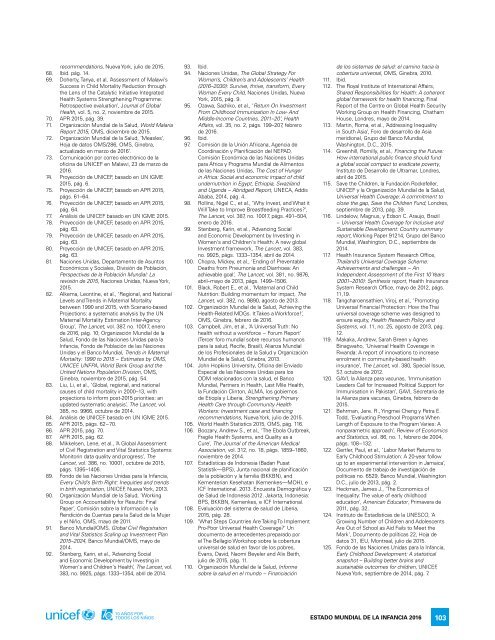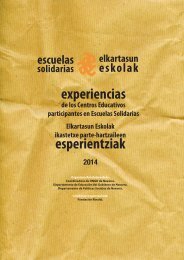Una oportunidad para cada niño
estado_mundial_de_la_infancia_2016
estado_mundial_de_la_infancia_2016
You also want an ePaper? Increase the reach of your titles
YUMPU automatically turns print PDFs into web optimized ePapers that Google loves.
ecommendations, Nueva York, julio de 2015.<br />
68. Ibid. pág. 14.<br />
69. Doherty, Tanya, et al, ‘Assessment of Malawi’s<br />
Success in Child Mortality Reduction through<br />
the Lens of the Catalytic Initiative Integrated<br />
Health Systems Strengthening Programme:<br />
Retrospective evaluation’, Journal of Global<br />
Health, vol. 5, no. 2, noviembre de 2015.<br />
70. APR 2015, pág. 39.<br />
71. Organización Mundial de la Salud, World Malaria<br />
Report 2015, OMS, diciembre de 2015.<br />
72. Organización Mundial de la Salud, ‘Measles’,<br />
Hoja de datos OMS/286, OMS, Ginebra,<br />
actualizado en marzo de 2016’.<br />
73. Comunicación por correo electrónico de la<br />
oficina de UNICEF en Malawi, 23 de marzo de<br />
2016.<br />
74. Proyección de UNICEF, basado en UN IGME<br />
2015, pág. 6.<br />
75. Proyección de UNICEF, basado en APR 2015,<br />
págs. 61–64.<br />
76. Proyección de UNICEF, basado en APR 2015,<br />
pág. 64.<br />
77. Análisis de UNICEF basado en UN IGME 2015.<br />
78. Proyección de UNICEF, basado en APR 2015,<br />
pág. 63.<br />
79. Proyección de UNICEF, basado en APR 2015,<br />
pág. 63.<br />
80. Proyección de UNICEF, basado en APR 2015,<br />
pág. 63.<br />
81. Naciones Unidas, Departamento de Asuntos<br />
Económicos y Sociales, División de Población,<br />
Perspectivas de la Población Mundial: La<br />
revisión de 2015, Naciones Unidas, Nueva York,<br />
2015.<br />
82. Alkema, Leontine, et al., ‘Regional, and National<br />
Levels and Trends in Maternal Mortality<br />
between 1990 and 2015, with Scenario-based<br />
Projections: a systematic analysis by the UN<br />
Maternal Mortality Estimation Inter-Agency<br />
Group’, The Lancet, vol. 387, no. 10017, enero<br />
de 2016, pág. 10; Organización Mundial de la<br />
Salud, Fondo de las Naciones Unidas <strong>para</strong> la<br />
Infancia, Fondo de Población de las Naciones<br />
Unidas y el Banco Mundial, Trends in Maternal<br />
Mortality: 1990 to 2015 − Estimates by OMS,<br />
UNICEF, UNFPA, World Bank Group and the<br />
United Nations Population Division, OMS,<br />
Ginebra, noviembre de 2015, pág. 54.<br />
83. Liu, Li, et al., ‘Global, regional, and national<br />
causes of child mortality in 2000–13, with<br />
projections to inform post-2015 priorities: an<br />
updated systematic analysis’, The Lancet, vol.<br />
385, no. 9966, octubre de 2014.<br />
84. Análisis de UNICEF basado en UN IGME 2015.<br />
85. APR 2015, págs. 62−70.<br />
86. APR 2015, pág. 70.<br />
87. APR 2015, pág. 62.<br />
88. Mikkelsen, Lene, et al., ‘A Global Assessment<br />
of Civil Registration and Vital Statistics Systems:<br />
Monitorin data quality and progress’, The<br />
Lancet, vol. 386, no. 10001, octubre de 2015,<br />
págs. 1395–1406.<br />
89. Fondo de las Naciones Unidas <strong>para</strong> la Infancia,<br />
Every Child’s Birth Right: Inequities and trends<br />
in birth registration, UNICEF, Nueva York, 2013.<br />
90. Organización Mundial de la Salud, ‘Working<br />
Group on Accountability for Results: Final<br />
Paper’, Comisión sobre la Información y la<br />
Rendición de Cuentas <strong>para</strong> la Salud de la Mujer<br />
y el Niño, OMS, mayo de 2011.<br />
91. Banco Mundial/OMS, Global Civil Registration<br />
and Vital Statistics Scaling up Investment Plan<br />
2015–2024, Banco Mundial/OMS, mayo de<br />
2014.<br />
92. Stenberg, Karin, et al., ‘Advancing Social<br />
and Economic Development by Investing in<br />
Women's and Children's Health’, The Lancet, vol.<br />
383, no. 9925, págs. 1333–1354, abril de 2014.<br />
93. Ibid.<br />
94. Naciones Unidas, The Global Strategy For<br />
Women’s, Children’s and Adolescents’ Health<br />
(2016–2030): Survive, thrive, transform, Every<br />
Woman Every Child, Naciones Unidas, Nueva<br />
York, 2015, pág. 9.<br />
95. Ozawa, Sachiko, et al., ‘Return On Investment<br />
From Childhood Immunization In Low- And<br />
Middle-Income Countries, 2011–20’, Health<br />
Affairs, vol. 35, no. 2, págs. 199–207, febrero<br />
de 2016.<br />
96. Ibid.<br />
97. Comisión de la Unión Africana, Agencia de<br />
Coordinación y Planificación del NEPAD,<br />
Comisión Económica de las Naciones Unidas<br />
<strong>para</strong> África y Programa Mundial de Alimentos<br />
de las Naciones Unidas, The Cost of Hunger<br />
in Africa: Social and economic impact of child<br />
undernutrition in Egypt, Ethiopia, Swaziland<br />
and Uganda − Abridged Report, UNECA, Addis<br />
Ababa, 2014, pág. 4.<br />
98. Rollins, Nigel C., et al., ‘Why Invest, and What it<br />
Will Take to Improve Breastfeeding Practices?’,<br />
The Lancet, vol. 387, no. 10017, págs. 491–504,<br />
enero de 2016.<br />
99. Stenberg, Karin, et al., ‘Advancing Social<br />
and Economic Development by Investing in<br />
Women's and Children's Health: A new global<br />
Investment framework, The Lancet, vol. 383,<br />
no. 9925, págs. 1333–1354, abril de 2014.<br />
100. Chopra, Mickey, et al., ‘Ending of Preventable<br />
Deaths from Pneumonia and Diarrhoea: An<br />
achievable goal’, The Lancet, vol. 381, no. 9876,<br />
abril–mayo de 2013, págs. 1499–1506.<br />
101. Black, Robert E., et al., ‘Maternal and Child<br />
Nutrition: Building momentum for impact, The<br />
Lancet, vol. 382, no. 9890, agosto de 2013.<br />
102. Organización Mundial de la Salud, ‘Achieving the<br />
Health-Related MDGs. It Takes a Workforce!’,<br />
OMS, Ginebra, febrero de 2016.<br />
103. Campbell, Jim, et al., ‘A Universal Truth: No<br />
health without a workforce − Forum Report’<br />
(Tercer foro mundial sobre recursos humanos<br />
<strong>para</strong> la salud, Recife, Brasil), Alianza Mundial<br />
de los Profesionales de la Salud y Organización<br />
Mundial de la Salud, Ginebra, 2013.<br />
104. John Hopkins University, Oficina del Enviado<br />
Especial de las Naciones Unidas <strong>para</strong> los<br />
ODM relacionados con la salud, el Banco<br />
Mundial, Partners in Health, Last Mile Health,<br />
la Fundación Clinton, ALMA, los gobiernos<br />
de Etiopía y Liberia, Strengthening Primary<br />
Health Care through Community Health<br />
Workers: Investment case and financing<br />
recommendations, Nueva York, julio de 2015.<br />
105. World Health Statistics 2015, OMS, pág. 116.<br />
106. Boozary, Andrew S., et al., ‘The Ebola Outbreak,<br />
Fragile Health Systems, and Quality as a<br />
Cure’, The Journal of the American Medical<br />
Association, vol. 312, no. 18, págs. 1859–1860,<br />
noviembre de 2014.<br />
107. Estadísticas de Indonesia (Badan Pusat<br />
Statistik—BPS), Junta nacional de planificación<br />
de la población y la familia (BKKBN), and<br />
Kementerian Kesehatan (Kemenkes—MOH), e<br />
ICF International. 2013. Encuesta Demográfica y<br />
de Salud de Indonesia 2012. Jakarta, Indonesia:<br />
BPS, BKKBN, Kemenkes, e ICF International.<br />
108. Evaluación del sistema de salud de Liberia,<br />
2015, pág. 28.<br />
109. ‘What Steps Countries Are Taking To Implement<br />
Pro-Poor Universal Health Coverage?’ Un<br />
documento de antecedentes pre<strong>para</strong>do por<br />
el The Bellagio Workshop sobre la cobertura<br />
universal de salud en favor de los pobres,<br />
Evans, David, Naomi Beyeler and Alix Beith,<br />
julio de 2015, pág. 11.<br />
110. Organización Mundial de la Salud, Informe<br />
sobre la salud en el mundo − Financiación<br />
de los sistemas de salud: el camino hacia la<br />
cobertura universal, OMS, Ginebra, 2010.<br />
111. Ibid.<br />
112. The Royal Institute of International Affairs,<br />
Shared Responsibilities for Health: A coherent<br />
global framework for health financing, Final<br />
Report of the Centre on Global Health Security<br />
Working Group on Health Financing, Chatham<br />
House, Londres, mayo de 2014.<br />
113. Martin, Roma, et al., ‘Addressing Inequality<br />
in South Asia’, Foro de desarrollo de Asia<br />
meridional, Grupo del Banco Mundial,<br />
Washington, D.C., 2015.<br />
114. Greenhill, Romilly, et al., Financing the Future:<br />
How international public finance should fund<br />
a global social compact to eradicate poverty,<br />
Instituto de Desarrollo de Ultramar, Londres,<br />
abril de 2015.<br />
115. Save the Children, la Fundación Rockefeller,<br />
UNICEF y la Organización Mundial de la Salud,<br />
Universal Health Coverage: A commitment to<br />
close the gap, Save the Children Fund, Londres,<br />
septiembre de 2013, pág. 39.<br />
116. Lindelow, Magnus, y Edson C. Araujo, Brazil<br />
− Universal Health Coverage for Inclusive and<br />
Sustainable Development: Country summary<br />
report, Working Paper 91214, Grupo del Banco<br />
Mundial, Washington, D.C., septiembre de<br />
2014.<br />
117. Health Insurance System Research Office,<br />
Thailand’s Universal Coverage Scheme:<br />
Achievements and challenges − An<br />
Independent Assessment of the First 10 Years<br />
(2001–2010): Synthesis report, Health Insurance<br />
System Research Office, mayo de 2012, págs.<br />
11,19.<br />
118. Tangcharoensathien, Viroj, et al., ‘Promoting<br />
Universal Financial Protection: How the Thai<br />
universal coverage scheme was designed to<br />
ensure equity, Health Research Policy and<br />
Systems, vol. 11, no. 25, agosto de 2013, pág.<br />
12.<br />
119. Makaka, Andrew, Sarah Breen y Agnes<br />
Binagwaho, ‘Universal Health Coverage in<br />
Rwanda: A report of innovations to increase<br />
enrolment in community-based health<br />
insurance’, The Lancet, vol. 380, Special Issue,<br />
S7, octubre de 2012.<br />
120. GAVI, la Alianza <strong>para</strong> vacunas, ‘Immunisation<br />
Leaders Call for Increased Political Support for<br />
Immunisation in Pakistan’, GAVI, Secretaría de<br />
la Alianza <strong>para</strong> vacunas, Ginebra, febrero de<br />
2015.<br />
121. Behrman, Jere. R., Yingmei Cheng y Petra E.<br />
Todd, ‘Evaluating Preschool Programs When<br />
Length of Exposure to the Program Varies: A<br />
non<strong>para</strong>metric approach’, Review of Economics<br />
and Statistics, vol. 86, no. 1, febrero de 2004,<br />
págs. 108−132.<br />
122. Gertler, Paul, et al., ‘Labor Market Returns to<br />
Early Childhood Stimulation: A 20-year follow<br />
up to an experimental intervention in Jamaica’,<br />
Documento de trabajo de investigación de<br />
políticas no. 6529, Banco Mundial, Washington<br />
D.C., julio de 2013, pág. 2.<br />
123. Heckman, James J., ‘The Economics of<br />
Inequality: The value of early childhood<br />
education’, American Educator, Primavera de<br />
2011, pág. 32.<br />
124. Instituto de Estadísticas de la UNESCO, ‘A<br />
Growing Number of Children and Adolescents<br />
Are Out of School as Aid Fails to Meet the<br />
Mark', Documento de políticas 22, Hoja de<br />
datos 31, IEU, Montreal, julio de 2015.<br />
125. Fondo de las Naciones Unidas <strong>para</strong> la Infancia,<br />
Early Childhood Development: A statistical<br />
snapshot – Building better brains and<br />
sustainable outcomes for children, UNICEF,<br />
Nueva York, septiembre de 2014, pág. 7.<br />
ESTADO MUNDIAL DE LA INFANCIA 2016<br />
103



